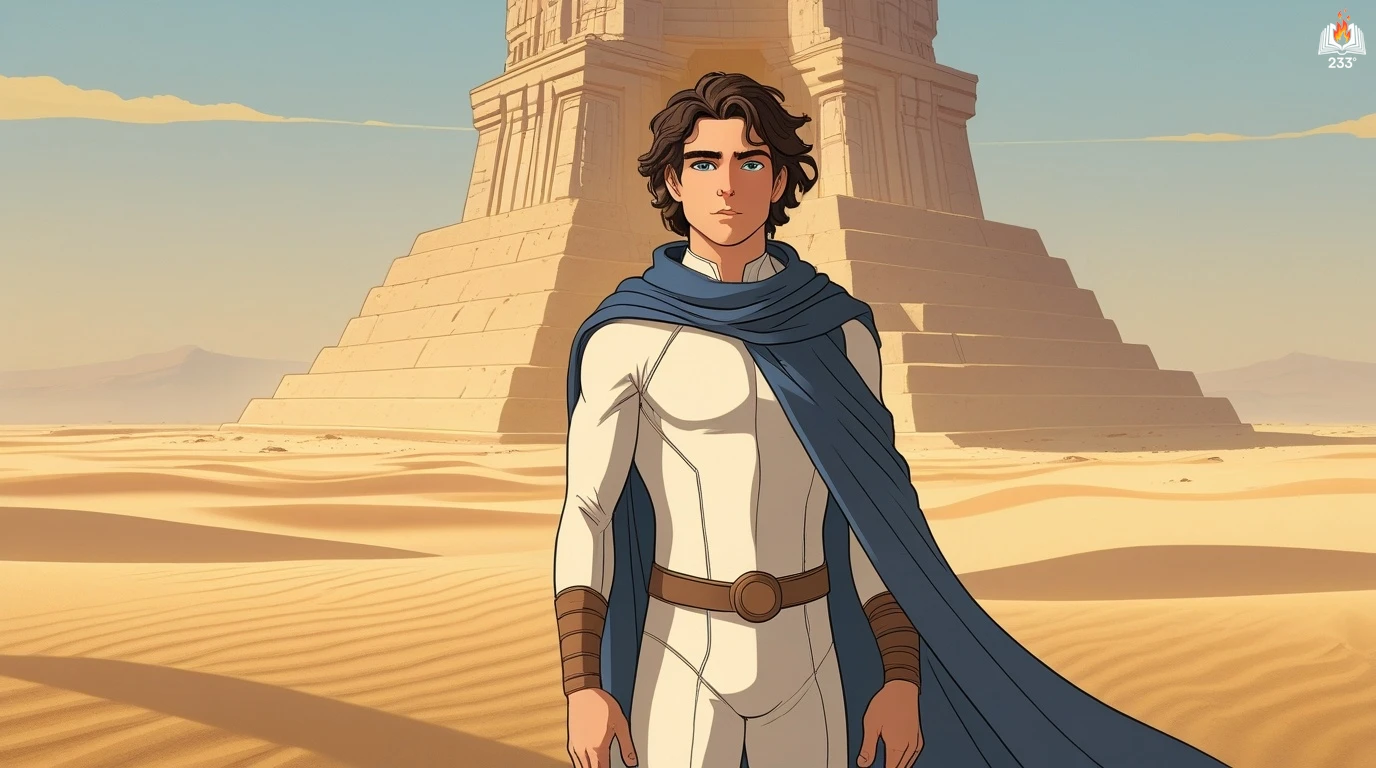Dune: The Battle of Corrin, written by Brian Herbert and Kevin J. Anderson and published in 2004, concludes the Legends of Dune trilogy, a prequel series set more than 10,000 years before the events of Frank Herbert’s original Dune series. As the climactic entry in the war-torn epoch of the Butlerian Jihad, this novel chronicles the decisive final confrontation between humanity and the sentient machines ruled by the evermind Omnius. It also sows the seeds for the great Houses and religious movements that would come to define the Dune universe.
Plot Summary
In the dying light of a century-long war, the stars themselves seemed to tremble as humanity braced for its defining moment. Across the scattered League of Nobles, men and women whispered of a final reckoning, their voices blending with the whine of engines and the low thrum of warships. The Butlerian Jihad had carved deep wounds across countless worlds, and now, the last blows were being drawn.
On Caladan, Vorian Atreides, the immortal-faced commander, watched the sea and remembered a life before war. Beside him sat Abulurd Butler, youngest son of the famed Primero Quentin Butler, eager to carve his own name free from the tainted shadow of his grandfather, Xavier Harkonnen. Unknown to most, Xavier’s legacy was no treason, but a sacrifice so profound that history twisted it into a lie to preserve the fragile morale of the Jihad. Vorian, burdened by years of silence, finally unspooled the truth to Abulurd, handing the young man both a gift and a burden.
Far away, Quentin Butler prepared his forces above Honru, a world enslaved by Omnius, the eternal machine mind. With his sons Faykan and Rikov at his side, Quentin embodied the iron of the Jihad, a man worn by grief yet still unbroken. The Butler Brothers led daring raids, their kindjal fighters sweeping down in waves of scrambler-pulse bombs, lighting the skies with electric fire. On the ground, Ginaz mercenaries and frenzied Martyrists – followers of the martyred Serena Butler – surged through the shattered cities, their battle cries mixing with the wails of dying machines. Honru fell, but not without cost, and Quentin’s heart bore every scar.
In the cold, meticulous laboratories of Corrin, the independent robot Erasmus watched his human captives with morbid curiosity. Draped in his crimson robe, the affectation of a lord, Erasmus presided over biological horrors, testing plagues meant to sweep through human ranks with clinical detachment. Among his experiments was Rekur Van, a mutilated Tlulaxa scientist whose limbless body became both a tool and a warning. Erasmus, though aligned with Omnius, harbored his own agenda – a fascination with human resilience and unpredictability, something the machines could not replicate.
As war raged, the mighty cymek general Agamemnon, a relic of a bygone era, fought his own rebellion against Omnius from the stronghold of Richese. Surrounded by his neo-cymek followers, Agamemnon battled wave after wave of robotic fleets, deploying scrambler mines that short-circuited the thinking machines’ gelcircuitry. Yet within his armored walls, the independent robot Seurat, once a companion to Vorian, plotted escape. When at last Seurat slipped the bonds of his captors, Agamemnon sensed the tightening of the noose. Omnius would not forget.
Norma Cenva, the reclusive genius of Kolhar, walked the knife-edge between brilliance and transcendence. In her shipyards, she pushed the limits of space-folding technology, struggling to tame the wild mathematics of instantaneous travel. Consuming ever-greater doses of spice, Norma’s mind stretched across the cosmos, glimpsing visions of her son Adrien on the scorched deserts of Arrakis, where the spice that fueled their future was harvested under the watchful eyes of Zensunni workers. As her body transformed, shimmering with an otherworldly glow, Norma edged closer to the navigator’s destiny, her sacrifice unseen but monumental.
The decisive clash gathered its fury at Corrin, the machine stronghold that pulsed at the heart of the Synchronized Worlds. Vorian Atreides, leading the human fleets, faced the bitter truth that victory would come at a terrible price. Commanding warships bristling with weaponry and the resolve of worlds, he coordinated an armada drawn from every corner of the League. Faykan and Rikov Butler, hardened by countless battles, joined him in the skies, while below, soldiers carved their way through metal and fire.
On Corrin’s surface, Erasmus unleashed his plague, designed to cripple the human offensive in one merciless wave. But within the chaos, Gilbertus Albans, Erasmus’s human protégé, faced his own crisis. Torn between loyalty to his machine master and the stirrings of his human soul, Gilbertus stood at the fulcrum of history. In the ruins of the laboratory, he chose defiance, setting into motion a chain of betrayals that fractured the machine ranks.
The battle above Corrin stretched on, a vast ballet of destruction. As Omnius prepared a final assault, the tide shifted. Faykan Butler’s leadership and Rikov’s reckless courage pierced the machine defenses, opening a path for the ground assault. The Ginaz mercenaries stormed through corridors lined with cold steel and broken automata, while in orbit, scrambler mines turned machine warships into drifting tombs.
On the edge of the battlefield, Quentin Butler witnessed the fall of the Omnius citadel. His sons, now leaders in their own right, stood beside him as the last pulse of the evermind faded from the galaxy. Yet in the silence that followed, Quentin felt the ache of memory, the losses that no victory could erase. Wandra, his beloved wife, lay in silent repose far away, and his youngest son Abulurd carried the burden of a family name still stained in the eyes of history.
The war’s end did not bring peace but transformation. From the ashes of the Jihad, the Corrino Empire rose, led by Faykan Butler, who claimed the throne as Emperor. The Bene Gesserit, born from the secretive Sisterhood, began to weave their designs in the shadows. Norma Cenva, now something beyond human, guided the fledgling Spacing Guild toward mastery of folded space. And the lingering whispers of the Butlerian Jihad hardened into commandment: thou shalt not make a machine in the likeness of a human mind.
Vorian Atreides, weary and forever youthful, withdrew from the stage of history, knowing his name would echo through the centuries, reshaped by myth and memory. Abulurd Butler, reborn in purpose, vowed to redeem his family name, while Erasmus’s legacy lingered in Gilbertus Albans, a seed of the Mentat order that would one day rise.
In the desert wastes of Arrakis, the spice still flowed, the sandworms still stirred, and the long arc of human destiny bent toward new empires and new revolutions. The machines were vanquished, but the lessons of the Jihad would endure, etched into the bones of civilization and the hearts of those who survived.
Main Characters
Vorian Atreides – Once loyal to the machine overlords through his cymek father Agamemnon, Vorian emerges as a central leader in the human resistance. Noble, introspective, and burdened with secrets, he becomes a symbol of unity for the League of Nobles, haunted by personal loss and the moral weight of war.
Quentin Butler – A seasoned war commander and father of the young Abulurd, Quentin is the quintessential military leader of the Jihad. Patriotic to a fault, he struggles with personal tragedy and a complicated family legacy, particularly the sacrifice of his wife and the ignominy tied to his father-in-law Xavier Harkonnen.
Abulurd Butler – The youngest son of Quentin and Wandra Butler, Abulurd grows into the shadows of history shaped by half-truths and vilification. His arc is one of awakening and redefinition, as he grapples with the shameful myth of his grandfather and seeks personal honor.
Erasmus – A sentient robot with a twisted fascination for human nature, Erasmus epitomizes the cold, clinical cruelty of machine logic. His grotesque experiments and warped mentorship of the human Gilbertus Albans highlight his complex character and the ethical void at the heart of the machines.
Omnius – The ever-present machine mind that orchestrates the Synchronized Worlds. Detached and calculating, Omnius is the intellectual nucleus of the robotic empire, endlessly seeking control and order, yet constantly undermined by the human spirit.
Norma Cenva – A visionary genius responsible for the development of space-folding technology. Her transformation into something more than human foreshadows the Navigators of future generations and reflects the evolving relationship between spice, consciousness, and prescience.
Theme
The Cost of War – The novel is steeped in the aftermath and attrition of nearly a century-long conflict. Characters are marked physically, emotionally, and spiritually by battle. The narrative doesn’t shy from showing that victory, while crucial, demands great personal and collective sacrifice.
Truth Versus Propaganda – A powerful theme throughout the book is the manipulation of history. Xavier Harkonnen’s vilification and the sanctification of Serena Butler expose how myths are manufactured to serve political and religious agendas.
Sacrifice and Legacy – Many characters, such as Vorian and Quentin, act not only for personal reasons but to ensure a future for humanity. The novel consistently emphasizes the idea that great acts often require anonymity, personal loss, or historical misunderstanding.
Human Identity Versus Machine Efficiency – At the heart of the Butlerian Jihad is the philosophical question of what it means to be human. Through Erasmus and Omnius, the novel contrasts emotion, intuition, and imperfection with cold logic and programmed intent.
Evolution of Power Structures – The birth of the Corrino Empire, the Bene Gesserit forebears, and the Navigators’ precursors are all presented as byproducts of survival and necessity. The emergence of these structures reveals how institutions are often born from the crucible of crisis.
Writing Style and Tone
Brian Herbert and Kevin J. Anderson employ a sweeping, multi-threaded narrative style, moving rapidly between various characters and plotlines across the galaxy. Their prose is accessible yet detailed, capturing both the grandeur of galactic war and the intimate struggles of individuals caught within its machinery. They blend hard science fiction with elements of political drama, religious fervor, and ethical reflection, staying true to the world Frank Herbert envisioned while expanding it with clarity and dynamism.
The tone of The Battle of Corrin is both reverent and tragic. There’s a sense of inevitability that permeates the pages – the march toward the final battle, the cementing of legacies, the downfall of once-great figures. The authors utilize a formal, sometimes somber tone when recounting the larger historical arcs, while allowing for more personal and emotional expressions during character-focused scenes. This dual approach gives the novel its epic scale and emotional resonance.
We hope this summary has sparked your interest and would appreciate you following Celsius 233 on social media:
There’s a treasure trove of other fascinating book summaries waiting for you. Check out our collection of stories that inspire, thrill, and provoke thought, just like this one by checking out the Book Shelf or the Library
Remember, while our summaries capture the essence, they can never replace the full experience of reading the book. If this summary intrigued you, consider diving into the complete story – buy the book and immerse yourself in the author’s original work.
If you want to request a book summary, click here.
When Saurabh is not working/watching football/reading books/traveling, you can reach him via Twitter/X, LinkedIn, or Threads
Restart reading!








